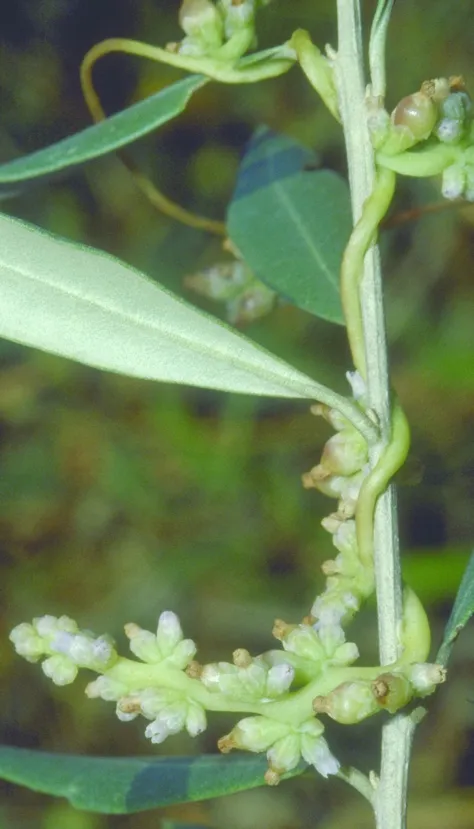Babylon Dodder
Cuscuta babylonica
Cuscuta babylonica grows in two neighboring regions: the Dead Sea and the Jordan
Valley. In the Dead Sea area the species grows only in its northern section –
it was collected for the first time in Kalya and Qumran in 1937, and was
collected again at the Kalya Junction in 1991. In the southern Jordan Valley C. babylonica was collected in Wadi Yitav (Wadi Uǧa), near the
settlement of Na'ama (= Na'omi) north of Jericho and at the Allenby Bridge on the
Jordan River. All collections are from the years 1982-1987.
Cuscuta
babylonica attaches to bushes and large shrubs, mostly Prosopis
farcta, but is also found on Retama raetam and Atriplex halimus
that grow on alluvial Lissan marl clay soils and on brown transition zone soils.
It grows in areas with precipitation of 100-170 mm and altitudes between -390
meters and +250 meters. In Turkey, it grows on perennial grasses and shrubs
along riverbanks and in gardens on steppes or in moist valleys at altitudes of
850-1200 meters.
Cuscuta
babylonica is a cosmopolitan genus with 145 parasitic species, found
in all the continents of the world, in both the Northern and Southern hemispheres.
In the Middle East, there are 21 species of Cuscuta and in Europe only
15. In Israel there are 12 species, all but one are annuals. It is parasitic on
herbaceous plants and characterized by their thin filamentous stems that lack chlorophyll.
Some species of Cuscuta cause extensive damage to agriculture, some of
them (e.g. C.epilinum)
are known for their specificity.
C.babylonica
grows in Israel only in the Sudanian enclave, and does not deviate from the extremely
hot Dead Sea and Jordan Valley areas. Its global distribution however, does not
show almost any affinity to the Sudan, but rather to the Irano-Turanian area,
where the temperatures are very low in winter: the species penetrates to
Central Asian regions with snowy and cold winters. Future research may reveal
that the Sudanian C.
babylonica populations in
the Jericho Valley, southern Iran and Pakistan are a separate taxon from the
Irano-Turanian populations
•
Cuscuta babylonica
grows in Israel at only four sites, all in the same geographical region (Jericho
Valley). In the past, other sites were known in that area and they are probably
extinct.
•
Only the Wadi
Malaha site is located within a nature reserve. Most other sites are being
threatened by nearby earthworks, whether for security reasons, for tourism or
agricultural development, transportation and industry (Dead Sea Works).
No rare species survey was carried out in the Jordan
Valley and the Dead Sea and all the data presented here are from the herbarium sheets,
personal knowledge and data from the Rotem center. Therefore, a detailed field
mapping of these regions should be conducted. Two sites, one in the area of the
Kalya Junction and one near the Jordan crossing at the “Baptism Site"
should be demarcated, and Cuscuta
babylonica should be monitored and its taxonomy and ecology studied.
Cuscuta
babylonica has a characteristic Irano-Turanian distribution: in
our region, it grows in Turkey, in the Syrian Desert, Iraq and Iran (absent in
Lebanon and Egypt), continues eastwards to Afghanistan, Trans-Caucasus and
Central Asia. From Jordan there is a single collection by Tuvia Kushnir from Qalirohy on the Dead Sea shore. The plant was first
described to science from Babylon (Iraq), and hence the specie name in Latin
and Hebrew.
Cuscuta
babylonica is an annual parasitic leafless
plant, with an Irano-Turanian distribution, although it grows
in the Levant only in one small area of the Jericho Valley. This is an area with
a Sudanian character, in which the natural habitats are being destroyed by
accelerated development and security related work. Today, only four of the seven
populations that were previously known have survived.
We are faced by
the question of whether a parasitic plant should be protected, particularly
when it can potentially parasitize agricultural plants and cause damage as a
result. C.babylonica
attacks only wild plants, while other Cuscuta
species are indeed harmful
to agricultural crops.
Current Occupancy Map
| 1000 squre meter pixel | 5000 squre meter pixel | 10000 squre meter pixel | |
|---|---|---|---|
| number of observations | 0 | 0 | 0 |
| in total pixels | 0 | 0 | 0 |
| Family | Convolvulaceae |
| Classification | On the endangered species list |
| Ecosystem | Desert |
| Chorotype | Western Irano - Turanian |
| Conservation Site | Kalya Salt Marsh, Qasr el Yahud and Baptism Site |
| Rarity |
1
4
6
|
|---|---|
| Vulnerability |
0
2
4
|
| Attractiveness |
0
0
4
|
| Endemism |
0
0
4
|
| Red number |
1
3.2
10
|
| Peripherality | 0 |
| IUCN category | DD EW EX LC CR EN VU NT |
| Threat Definition according to the red book | Vulnerable |
 Based on:
Based on:





